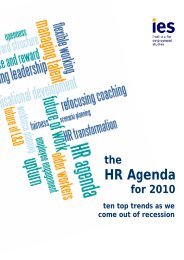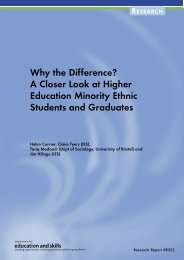Post-16 Transitions: a Longitudinal Study of Young People with ...
Post-16 Transitions: a Longitudinal Study of Young People with ...
Post-16 Transitions: a Longitudinal Study of Young People with ...
Create successful ePaper yourself
Turn your PDF publications into a flip-book with our unique Google optimized e-Paper software.
needs in both the academic and the social and personal domains.<br />
For others though, this was not always the case.<br />
In addition to concerns about the coherence <strong>of</strong> multi-agency<br />
support, there is the question <strong>of</strong> the stability <strong>of</strong> such an<br />
arrangement. It is not at all clear, and actually very unlikely, that<br />
these champions or workers will remain constant as provision<br />
shifts from child to adult services, and as young people change<br />
activities. Moreover, the support ‘systems’ described here seem to<br />
be geared to helping young people <strong>with</strong> severe or ‘uncontested’<br />
impairments. These young people constitute a relatively wellknown<br />
population for whom there are clear transition pathways<br />
and systems in place.<br />
Underpinning any agency support that young people received<br />
were parents and carers who provided the largest degree <strong>of</strong> help,<br />
stability and continuity for the young person post-<strong>16</strong> as they did<br />
pre-<strong>16</strong>. The powerful commitment <strong>of</strong> parents and carers, although<br />
not always fully harnessed, was a striking feature <strong>of</strong> the case<br />
studies.<br />
10.2.5 School outcomes<br />
Encouragingly, most young people taking part in the survey had<br />
gained some sort <strong>of</strong> qualification at the end <strong>of</strong> compulsory<br />
schooling, the majority <strong>of</strong> these being a Level 1 equivalent<br />
qualification, and many had gone on to get additional<br />
qualifications and certificates post-<strong>16</strong>. However, young people<br />
who had a statement <strong>of</strong> SEN, who had attended a special school,<br />
and/or who had behavioural, emotional or social development<br />
needs were less likely to have achieved any qualifications on<br />
completing compulsory schooling leaving them in a much lower<br />
starting position than their peers.<br />
10.3 Success <strong>of</strong> transition<br />
A key indicator <strong>of</strong> progression and a successful transition for<br />
young people leaving compulsory schooling is their post-<strong>16</strong><br />
activity. Not surprisingly, the survey found that young people<br />
<strong>with</strong> SEN most commonly continued in (primarily) full-time<br />
education in FE institutions, schools and sixth form colleges.<br />
<strong>Young</strong> people were particularly likely to have continued in<br />
education post-<strong>16</strong> if they had had a statement <strong>of</strong> SEN, had<br />
attended a special school and had sensory and/or physical<br />
disabilities.<br />
Whilst continuing education is a positive (and fairly ‘normal’)<br />
activity for young people on completing compulsory schooling,<br />
these findings lend weight to the hypothesis that many young<br />
people <strong>with</strong> SEN, by remaining in their familiar school<br />
environment or in special FE provision, may have ‘deferred’ their<br />
<strong>Post</strong>-<strong>16</strong> <strong>Transitions</strong> <strong>of</strong> <strong>Young</strong> <strong>People</strong> <strong>with</strong> SEN: Wave 2 141

















